|
 |
|
HOME
ARTICLES
GALLERIES
ABOUT US
FORUM
LINKS CONTACT
JOYLAND BOOKS |
|
GOLDEN OLDIES:
BRITAIN'S AMUSEMENT PARK HERITAGE
by Nick Laister
Gallery: From Joyland Books Exhibition Hall, 1 May 2001 to 30 June
2001 |
This article originates from
the now defunct Joyland Books Exhibition Hall and was online for two months only
in May and June 2001. It proved to be the most popular of all the exhibitions
that Joyland displayed over several years. It is something of a curiosity now
because no less than half of the rides featured are now either demolished,
dismantled or standing but not operating. Most of the photographs are the ones
used in the original article, but new photographs have been added where the
originals were of exceptionally poor quality.
|
Introduction: Golden Oldies
by Nick Laister Whilst Britain has a wonderful amusement park heritage, vintage parks and rides
continue to be lost. Earlier this year we hosted an exhibition bemoaning the
biggest loss to our amusement park heritage for the past quarter of a century: the
closure of Frontierland at Morecambe. The loss of this park is
very sad, as is the loss of rides such as the 1937 Texas Tornado wooden roller coaster
and the unique Noah's Ark. The list of parks that have closed or announced they are
closing over the past two years is long: besides Frontierland, the list includes Spanish
City (Whitley Bay), Seaburn Fun Park (Sunderland), Fun City (Skegness), Marvel's Amusement
Park (Scarborough), and Dizzyland (Southend). Others are known to be under threat.
Of course, rides will always be lost due to progress, and I for one strongly
support progress. But not a single amusement park ride in the United
Kingdom is protected by statutory listing, yet many would be eligible under the terms of
the Listed Buildings Act. To be listed, a structure has to be old, rare and of merit or
importance. Of
course, listing a ride does not guarantee its preservation, but at the very least
it forces those planning a ride's demolition to think about the options. As has been proved
with many other forms of development, a requirement to preserve a structure can actually
result in surprisingly innovative solutions being drawn up. Of course, this
approach would not be right for all parks, particularly those that are not under
threat of closure. In such cases it could stifle the park owners and make it
more difficult for them to invest. Listing should be used sparingly!
This exhibition
is a celebration of Britain's oldest surviving rides. These are not rides that are
'hanging by a thread'; some of the UK's best vintage rides are still making a living
decades after they were opened in hugely popular amusement parks. (By 'vintage', we have
taken 1940 as an arbitrary threshold after which a ride is no longer considered to be
vintage).
If anyone has
any further information about any of the rides featured here, or can provide details of
any other pre-1940 rides at amusement parks that we haven't included, please email us. Otherwise, just sit back, relax,
and let us take you on a leisurely tour around some of the best old rides that Britain has
to offer. One final note: We have excluded gallopers from our survey of vintage rides, as
these machines were featured in an exhibition of their own in September 2000, Gallopers
at the Amusement Park.
|
 |
|

Image:
Nick Laister

Image: Nick Laister

Image: Nick Laister
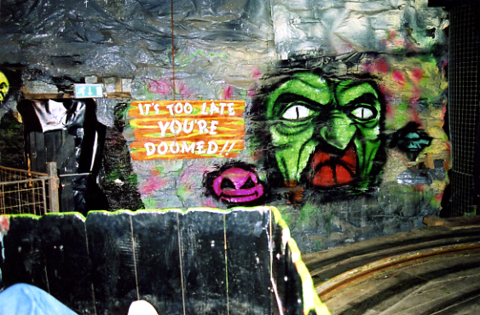
Image: Nick Laister

Image: Nick Laister |
Haunted
Mine, Barry Island Pleasure Park
Although rides
have been located on the site of the present Barry Island Pleasure Park since around the
turn of the last century, a permanent amusement park was established here in 1922.
This 2001 photograph shows the frontage of the
ride and the exit.
The park has
been in various ownerships through the years, but most notably from 1930 to the 1990s it
was owned by showman John Collins, who installed the Haunted Mine (previously known as the
Wacky Goldmine).
This is another view of the ride frontage from
2002. (This photograph was not used in the
original article).
This ride is
notable only because it was built using the wood from the ride which preceded it, the
Scenic Railway roller coaster, built in 1939.
The photograph on the left was taken inside the
ride in 2001.
This 2002 photograph shows some of the internal
theming. "It's too late. You're doomed!!" (This
photograph was not used in the original
article).
A car returns to the station in 2001. |
|
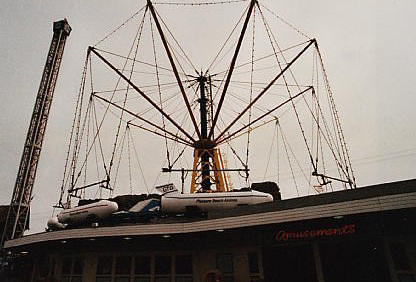
Image:
Dave Page

Image:
Dave Page

Image:
Dave Page
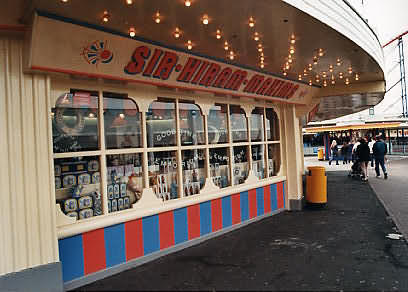
Image: Dave Page |
Sir Hiram Maxim's Captive
Flying Machines
Opened in
August 1904, this is the only surviving Flying Machine ride in the world, and the Pleasure
Beach’s oldest ride.
A steel pole
62 feet high supports ten arms, from which hang carriages. As the ride revolves, the
carriages spread outwards, hence creating the illusion of flying.
This antique
machine still operates successfully today amongst the high-tech thrill rides.
Underneath the
ride is Sir Hiram Maxim's Emporium inside which can be viewed the historic workings of the
ride.
.
|
|
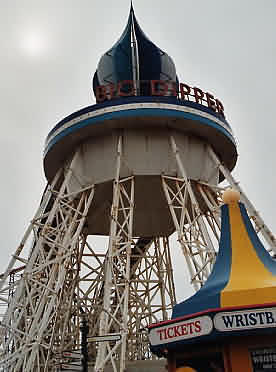
Image:
Dave Page
.jpg)
Image: Gary
Radice

Image: Nick Laister
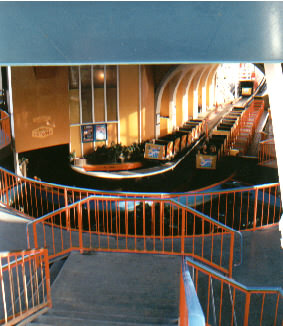
Image:
Nick Laister
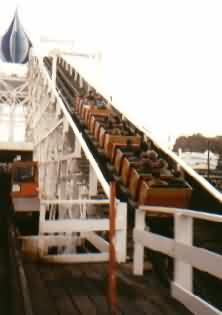
Image: Nick
Laister

Image: Nick Laister

Image: Nick Laister |
Big Dipper,
Blackpool Pleasure Beach
The Pleasure
Beach’s oldest coaster, and the first in the UK to use under-track wheels, opened on
23 August 1923. This photograph shows the Big Dipper entrance.
This wooden
coaster was designed by legendary coaster builder John Miller (the inventor of the
modern-day roller coaster). In 1936, the ride was extended by 200 feet, with an additional
dip added, and the existing dips were steepened. The ride was given new streamlined trains
in 1937. This photograph shows the second drop.
The Big Dipper is still
very
popular in the 21st Century.
The Big Dipper's huge loading
station (1992).
Climbing the second lift hill
(the Big Dipper actually has two).
The first drop! This picture
was taken in 1993; one year later and the view from the top of the Big Dipper's first drop
was to change significantly.
This general view shows the
ride in all its glory, with the Big One behind. |
|
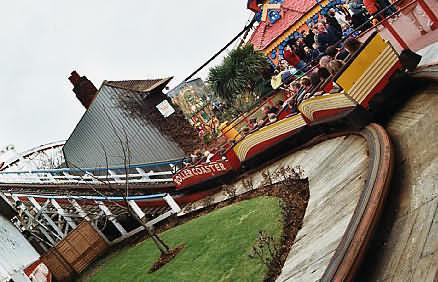
Image:
David Page
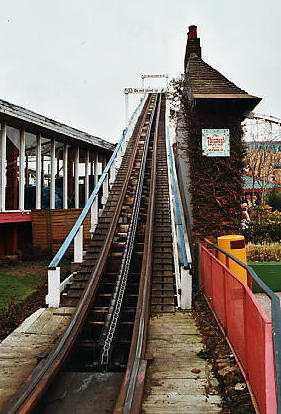
Image: David Page
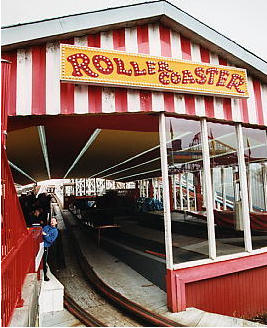
Image:
David Page

Image: David Page
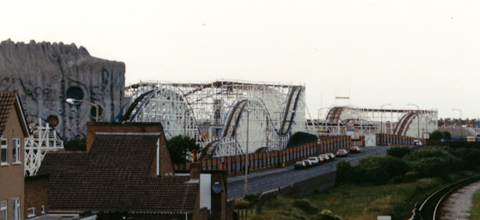
Image: Nick Laister |
Roller
Coaster, Blackpool Pleasure Beach
The
Roller Coaster is a substantial rebuild of an earlier wooden coaster at the Pleasure
Beach, the Velvet Coaster.
The
Velvet Coaster was constructed in 1909, and was designed by William H. Strickler. In 1933,
the Velvet Coaster had to be moved to accommodate a new road, and was reconstructed in a
different design by Charles Paige (of John Miller’s Milleride Company).
The ride's massive station is
partially hidden behind the Watson Road overpass.
The
ride is 2,400 feet in length and, uniquely amongst BPB's roller coasters, operates without
lap bars.
This 1992 view from
the rear of the park shows the Roller Coaster in all its glory, with the Grand National
behind. |
|
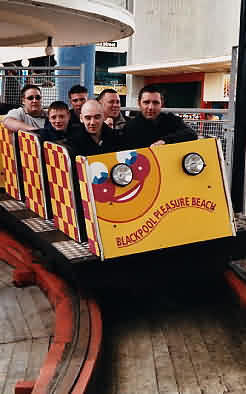
Image: David Page
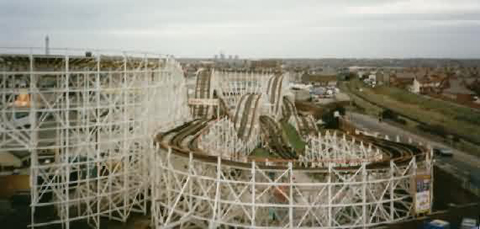
Image: Nick Laister
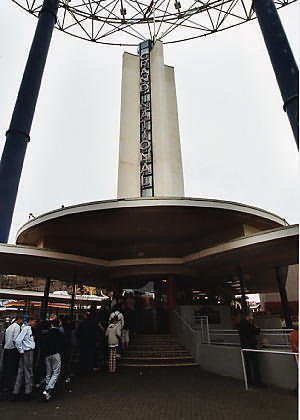
Image: David Page
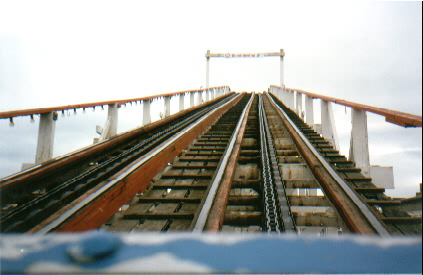
Image: Nick Laister

Image: Nick Laister
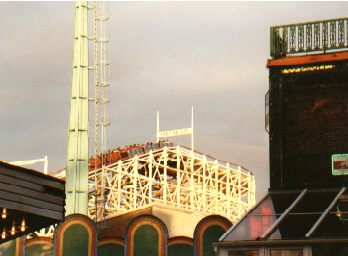
Image: Nick Laister |
Grand National,
Blackpool Pleasure Beach
Built by
Charles Paige in 1934/5, this is a wooden, twin track, racing roller coaster.
This is one of
only three racing coasters in the world to feature a ‘Mobius’ loop, which gives the illusion
of twin tracks, when it is in fact only one track. This has the result of the trains
'magically' swapping tracks after each ride. Each loop is 3,400 feet long, and the ride is
72 feet high. The other similar rides are the 1927 John Miller-designed Racer at Kennywood Park, Pittsburgh, USA
and the 1964 Montaņa Rusa at La Feria Chapultepec Magico, Mexico
City.
Although
architect Joseph Emberton’s original station was demolished, a replica was built in
1990.
Climbing the lift hill in the
blue train.
At the top of the first drop,
the green train takes the lead. Note that the green train is about to enter the double
drop.
|
|
.jpg)
Image: Gary Radice
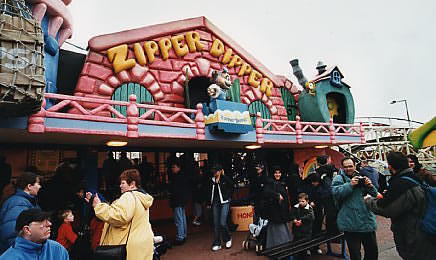
Image: David Page

Image: Nick Laister
|
Zipper Dipper,
Blackpool Pleasure Beach
The Zipper
Dipper is a small wooden roller coaster for children. It was constructed in 1934 as a
younger companion to the Big Dipper, and was originally called the Little Dipper! Here it
can be seen sandwiched between the much larger Roller Coaster and another children's ride
in the Beaver Creek section of the Pleasure Beach.
The ride was
constructed by either Charles Paige or Harry G. Traver, and has recently been given a
bright new station facade.
Inside the Zipper Dipper's
colourful station. |
|
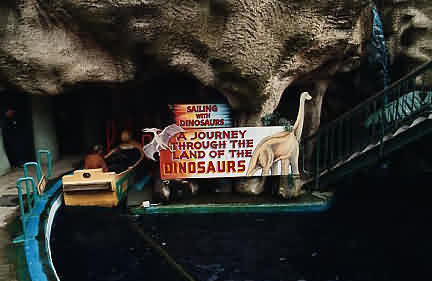
Image: David Page
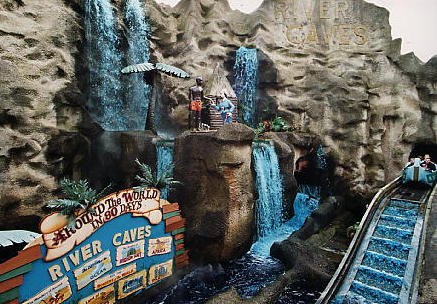
Image: David Page |
River Caves, Blackpool
Pleasure Beach
This ride,
designed by Lot Morgan, originally opened at London’s Earl’s Court in 1909, but
was moved to the Pleasure Beach in 1910. (Some reports suggest that the ride was
constructed at the Pleasure Beach in 1905).
Passengers are
carried through underground caverns featuring scenes from around the world. This
spectacular ride covers one and a half acres. The ride still operates, although is much
rebuilt.
|
|
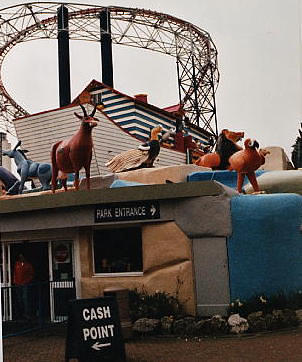
Image: David Page
.jpg)
Image: Gary Radice

Image: Nick Laister |
Noah's Ark, Blackpool
Pleasure Beach
This
walk-through fun house, in the shape of an Ark, surrounded by mechanical animals, and
rocking backwards and forwards as if in the sea, was built by William H. Strickler, and
opened in 1921.
The ride was
completely renovated in 1996, the Pleasure Beach’s centenary year.
Blackpool Pleasure Beach has
created its own "National Historical Markers", a clever way of adding interest
to its historic attractions. Unfortunately, following the demolition of the Frontierland
Ark a few months ago, there is now only one other Noah's Ark in operation: at Kennywood,
Pittsburgh, USA.
|
|
Next |
|
|
THEMAGICEYE
|
Terms
and Conditions |
Privacy Policy
|
Contact Us |





.jpg)












.jpg)
















.jpg)
